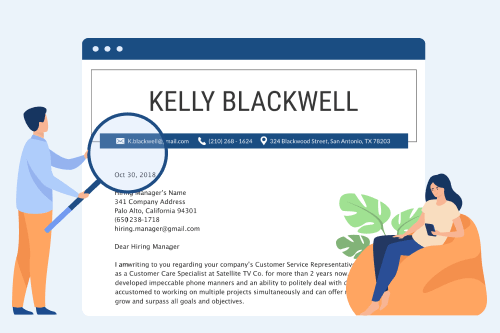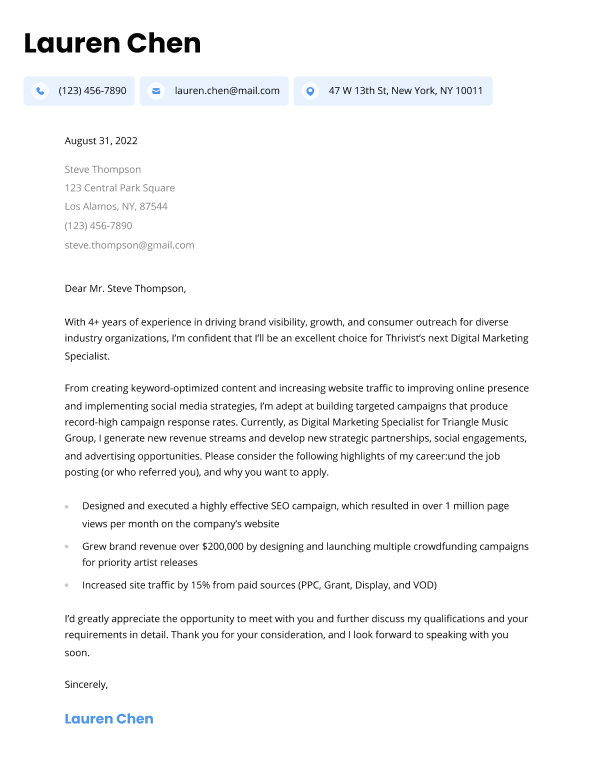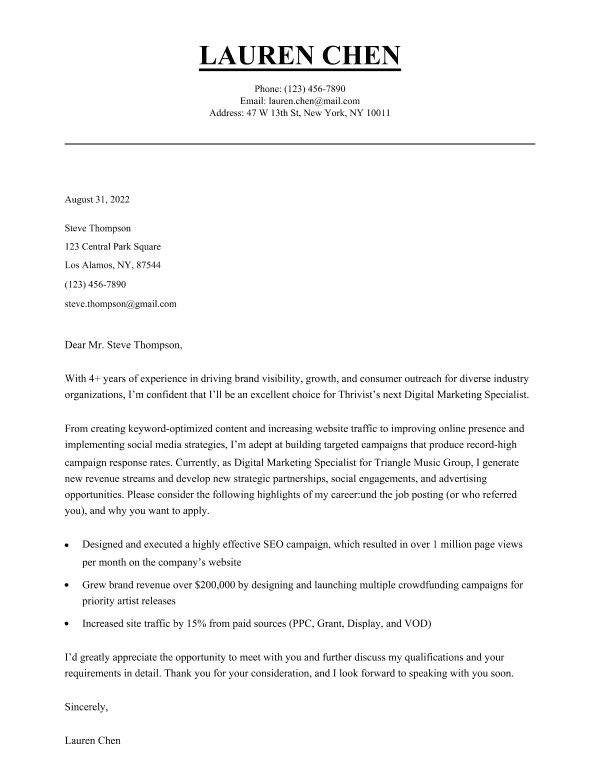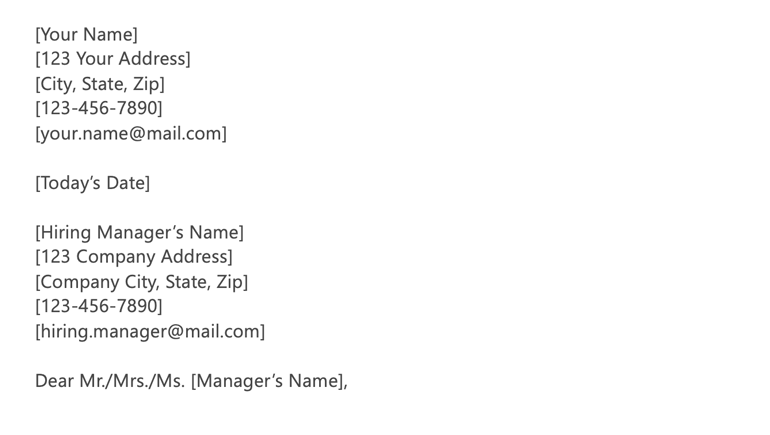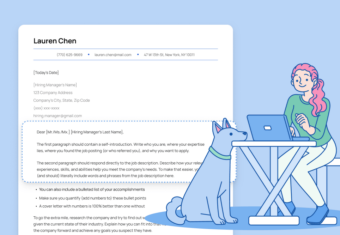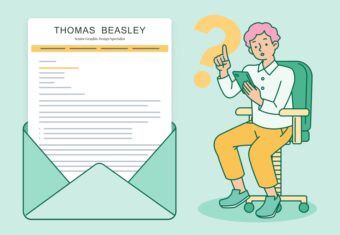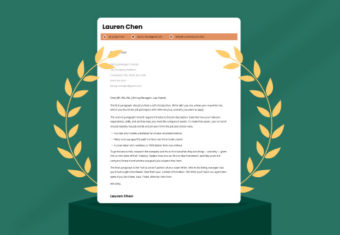Below, we’ll give you examples of both traditional and modern cover letter headers and show you how to organize your information correctly.
Our free-to-use cover letter builder can make you a cover letter in as little as 5 minutes. Just pick the template you want, and our software will format everything for you.
Traditional cover letter headers
A traditional cover letter header typically lists your contact information and that of the hiring manager on the left side of the page.
Though this format takes up a lot of space, some applicants still prefer it. Here’s an example of what a traditional cover letter header looks like:
To save space, the best way to format your cover letter header is by horizontally aligning your contact information at the top of the page. Then, you can left-align the hiring manager’s contact information underneath.
Here are examples of space-saving, professional cover letter headers you can use:
Example 1
Here’s an example of a traditional cover letter header in black and white:

Example 2
If you want to liven up your cover letter, use a different color in your header. Just remember to use appropriate cover letter fonts and colors that are readable and work-appropriate.
This cover letter header uses a green color as its background:

Example 3
Using color for your first and last name also makes your header stand out to employers, like this example:

Creative cover letter headers
If you’re aiming to stand out as a unique job candidate, creative cover letters are an excellent way to customize your cover letter and resume design and show off your graphic design skills.
Writing a cover letter with a design that including icons, using more vibrant colors, and adding a customized background image captures the attention of employers, especially if you’re applying to creative industries.
Example 4
This cover letter heading uses a city image for its background:

Example 5
This applicant uses a box to separate their name from their contact details. They also include their job title:

Example 6
You can also try a logo to display your initials or represent your personal brand, like this example:

Example 7
This cover letter header uses a blend of color, a specialized font, and icons to capture the attention of hiring managers:

Not a designer or simply don’t have the time to make your own template? Try using an online cover letter template to save time and choose from a variety of options.
What to include in your cover letter header
Required contact details
- Your name
- Phone number
If your header contains all of your contact details, employers can more easily call you in for an interview.
Name
First, include your first and last name in your cover letter header.
Hiring managers search for you on the internet, so use the name from your professional online profiles. If you have a nickname or recently changed your name, use your most searchable name.
To make your name stand out to employers, try capitalizing your first and last name and using a larger font size than the rest of the header.
Most hiring managers will email you to ask more questions about your application or to set up an interview, so make sure your email address is up to date.
Use an appropriate email address from a reputable free email service such as Gmail or Outlook. For example, using [firstname][lastname]@gmail.com is highly professional.
Don’t use an unprofessional email address. For instance, avoid an email address like dustyjoebomb911@gmail.com.
If you’re submitting an email cover letter or email resume, make your email address clickable so employers can contact you directly online.
Phone number
Finally, some hiring managers may want to conduct a phone interview or call you to set up an interview time, so add your phone number to your cover letter header.
It’s best to use your most commonly used phone number to ensure you don’t miss any calls.
Optional additions to your cover letter heading
- Current job title
- Mailing address
- Online portfolio or website
Current job title
Your title provides employers with a glimpse at your experience and lets them know what role you’re focused on getting.
If you’re unemployed or hoping to land a role in a new industry, you can write “Aspiring” before the job title you want. For instance, you’d write, “Aspiring UI/UX Designer” if you’re an entry-level designer looking to break into the field.
Don’t forget to mention your licenses and certifications in your job title if they’re essential for the role you’re applying for. For example, if you’re a “Certified Public Accountant,” add “CPA” to your heading.
Mailing address
Most companies have digitized their hiring processes, so including your address on your cover letter header is optional.
If you decide to put your address on your cover letter header, write your full mailing address. Here’s an example of an applicant’s mailing address on their header:
1444 Burton Avenue, Memphis, TN 38117
Alternatively, you can write down only your city and state, like this:
Memphis, TN
Hiring managers use LinkedIn to screen applicants. Adding your LinkedIn profile to your cover letter header lets hiring managers easily find you on this platform.
To make your profile URL look cleaner, personalize your LinkedIn web address by clicking “Edit public profile & URL” on the upper right corner of your LinkedIn profile:
Try to use your name in the web address. Including your name in your profile’s URL looks tidy and professional on your cover letter header.
Present yourself as a strong applicant by preparing a LinkedIn summary for employers to see when they click on your LinkedIn profile.
If you work in a creative or tech field like design, gaming, or marketing, sharing your Twitter handle shows employers that you’re involved with the latest work trends and news.
Remember only to provide your business Twitter handle, and make sure your tweets are public and work-appropriate.
Online portfolio or website
Providing your digital portfolio or personal website is ideal for companies who want to see your previous work, so add it to your cover letter header.
Your portfolio or website also helps to showcase your personality and hobbies and interests, so hiring managers have a better idea if you’re a good fit for their team.
Should the header of my cover letter match my resume?
Your resume header should match your cover letter header because it makes finding your contact information easier for employers, especially if they print out your application.
Additionally, matching resume and cover letter headers create a consistent appearance that shows you put effort into making your application neat and professional.
If you use a two-column resume header, make sure your cover letter header also uses the same font and color scheme. Take a look at this two-column resume and its matching cover letter:
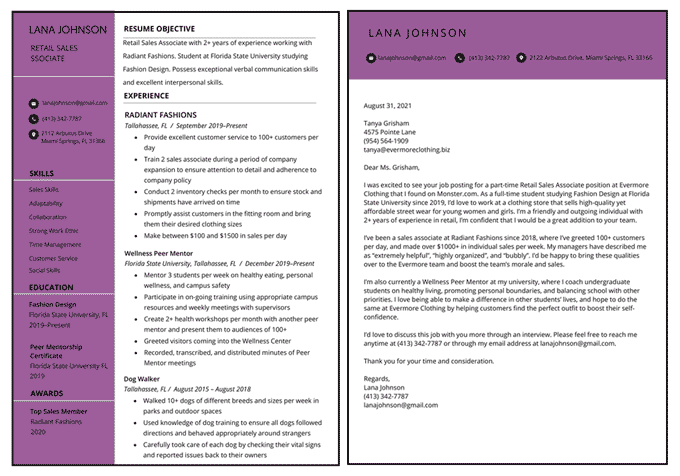
Click to rate this article
4.1 Average rating


